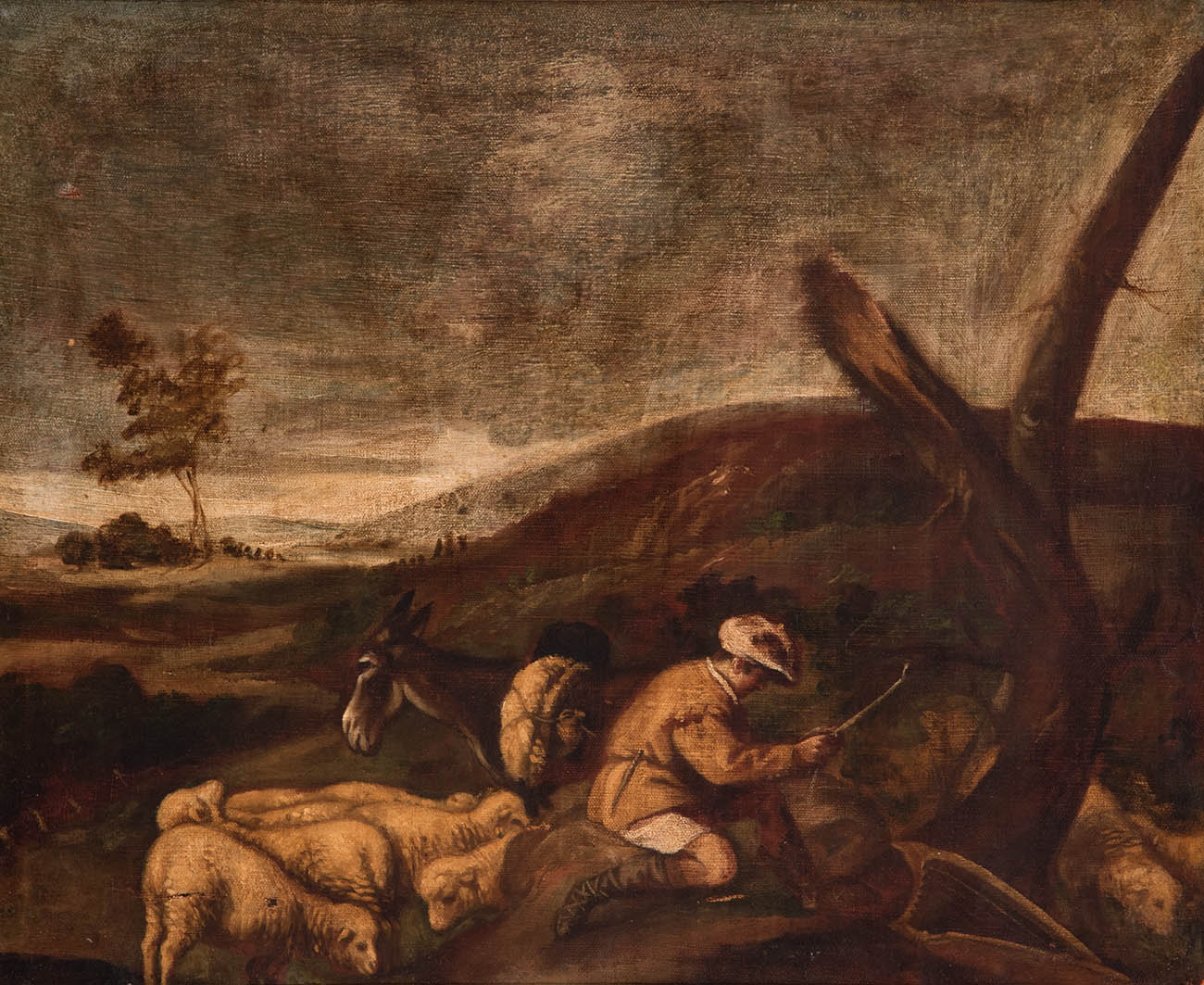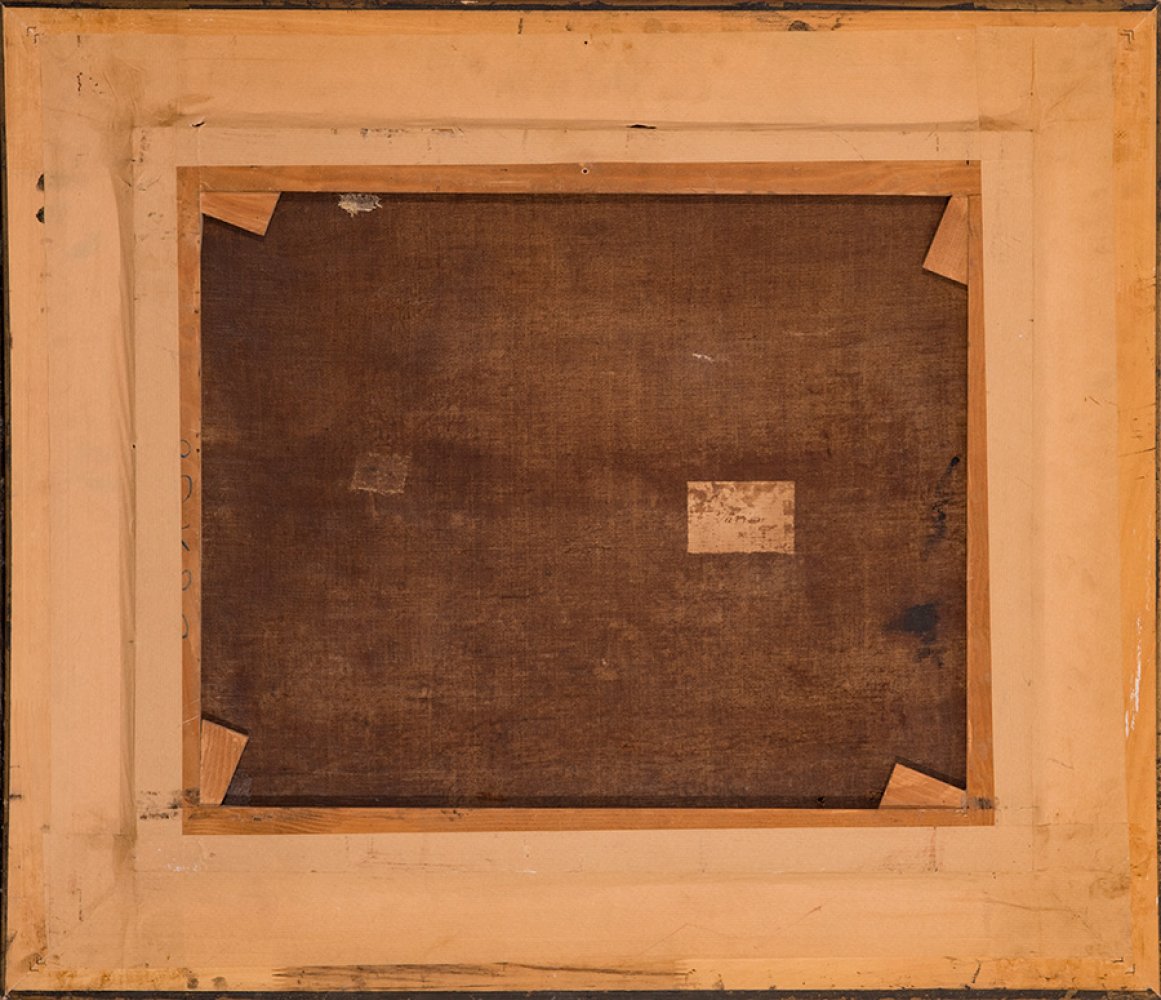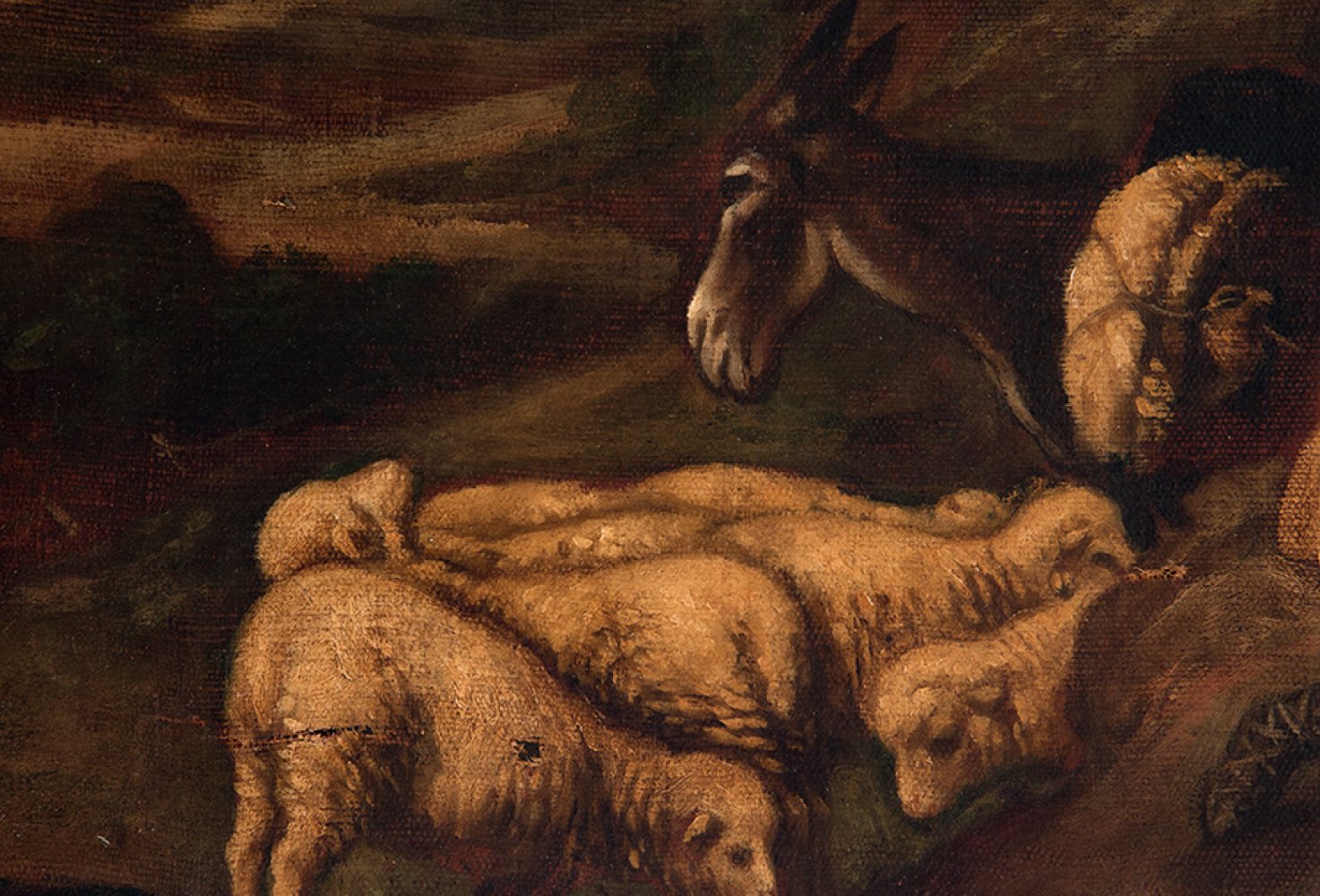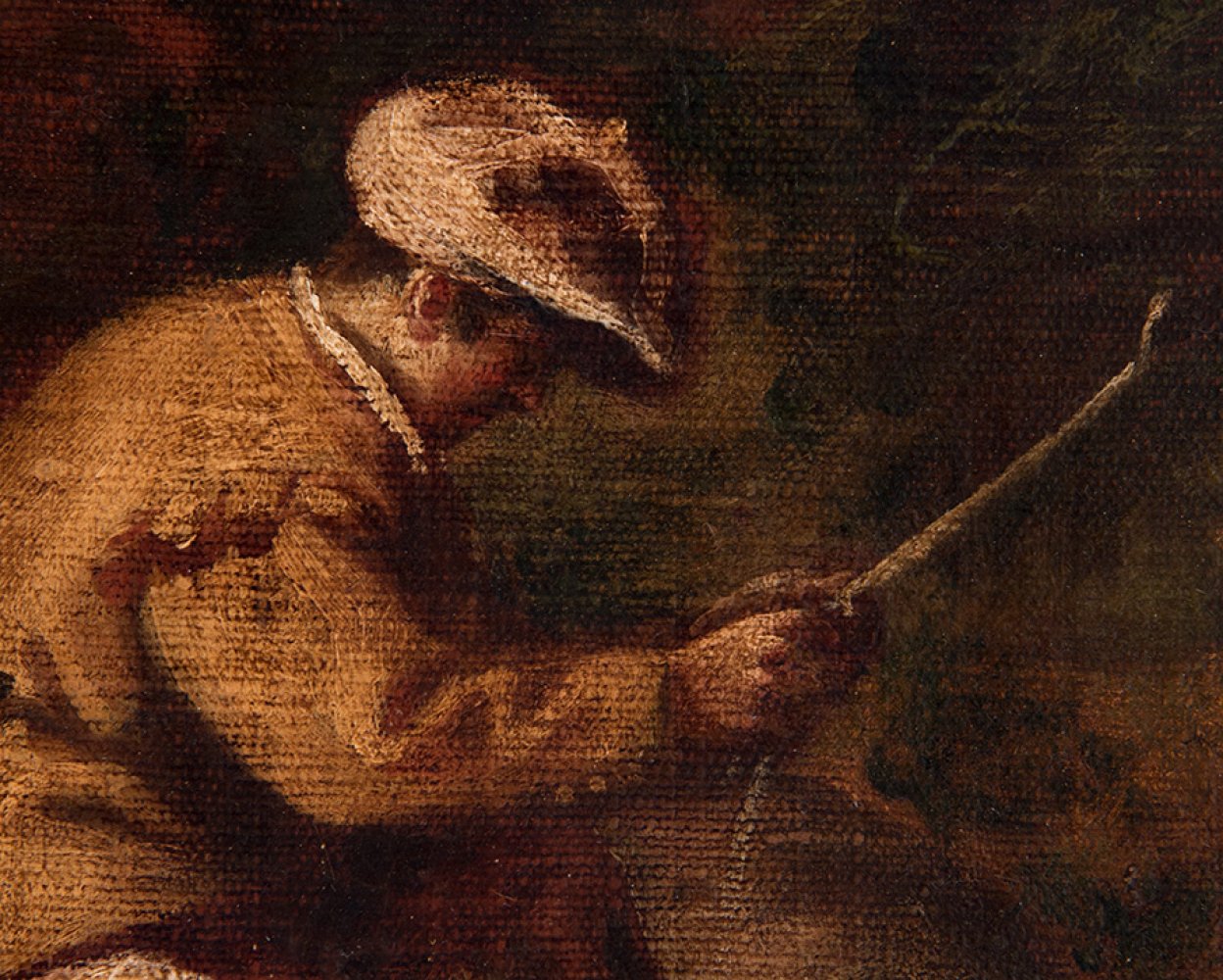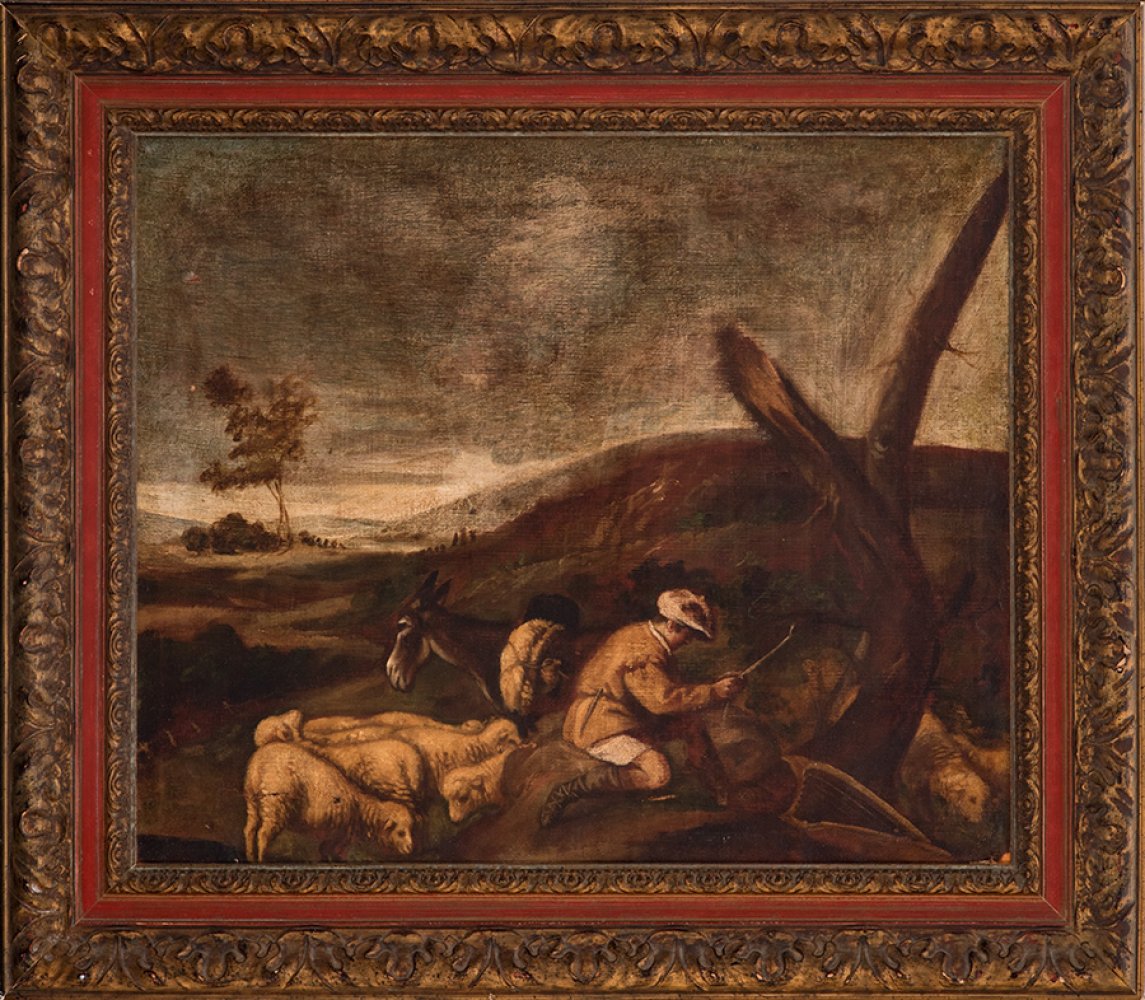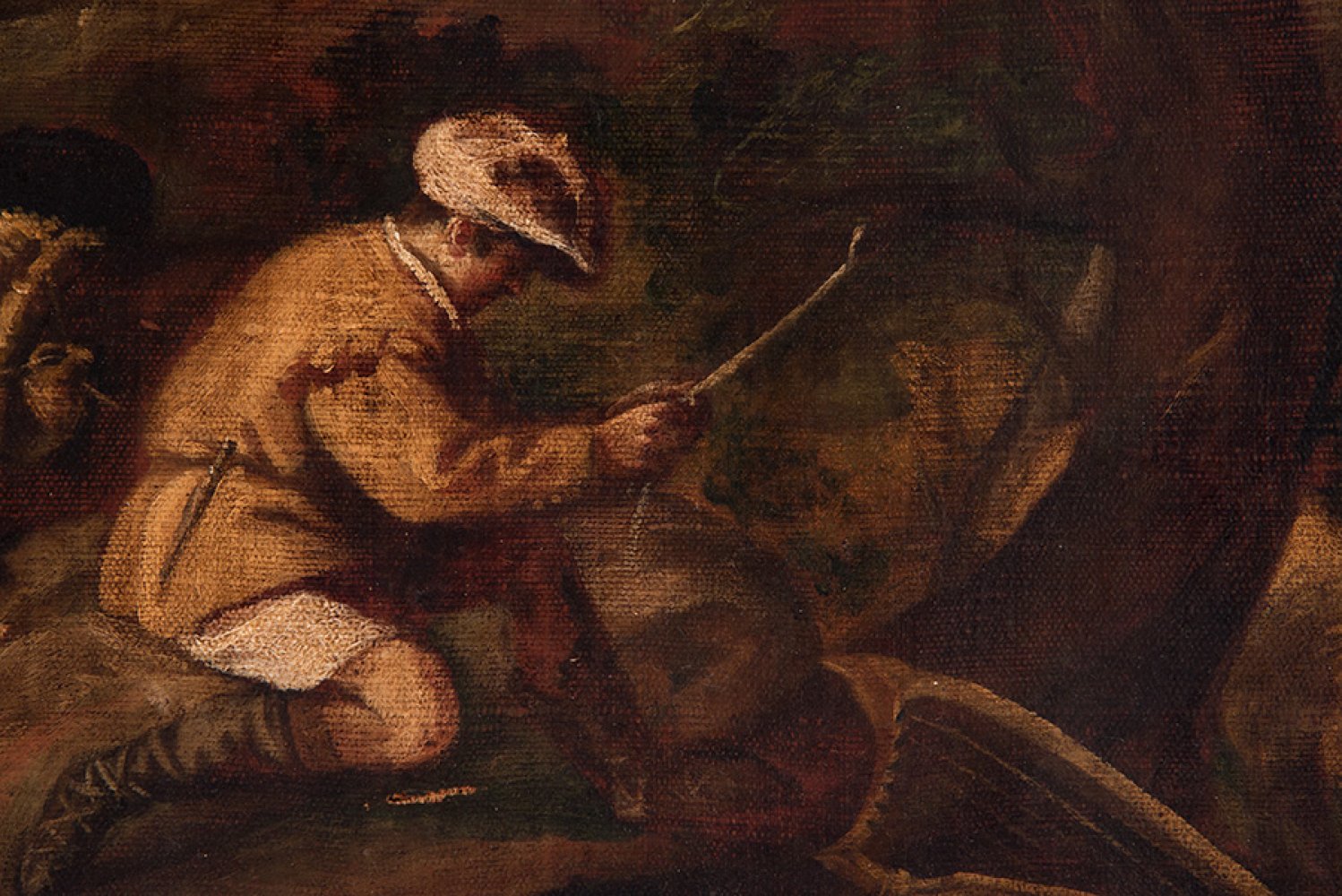13
Workshop of PEDRO DE ORRENTE (Murcia, 1580 - Valencia, 1645)."Pastoral scene for a passage from
"Pastoral scene for a passage from the Old Testament".
Oil on canvas.
Relined.
Size: 57 x 69 cm; 76,5 x 88 cm (frame).
During his stay in Venice, Pedro de Orrente must not only have learned the pictorial manners of the Bassano family, but he would also take on their conception of painting as a market-oriented activity. His treatment of sacred themes as genre scenes would be fundamental in this respect. These were, above all, lively series of biblical stories with which fans could be flattered by the variety and dynamism of the works, populated by a large number of characters set in landscapes and accompanied by all kinds of animals and everyday objects. In the present work we seem to recognise David by the harp resting at his side, but he is depicted as a shepherd with his sheep. This is a workshop work by the painter Pedro de Orrente.
Known as "the Spanish Bassano", Pedro Orrente was a highly successful artist of his time, admired as a follower of the formulas of the famous Venetian family of artists, especially in his series of Old Testament themes set in lush landscapes. He lived in several Spanish cities, moving from his native Murcia to Toledo at a very young age, where he was already in 1600. If the fame of the Bassano family's works was enormous throughout Spain, the climate in the Castilian city must have been particularly receptive to their painting, as the works of the best masters who worked there attest. It is therefore not surprising that Orrente, who shortly afterwards travelled to Italy, went to Venice, where we find him as early as 1605. It is quite reasonable to think that he passed through the workshop of Leandro Bassano, whom Jusepe Martínez classified as his master. In 1607 he was already back in Spain, settled in Murcia. He continued to visit other Spanish cities, especially Toledo and Valencia, although he must also have spent time in Madrid. During his stay in Venice he must not only have learnt the Bassano family's pictorial manner but also took on board their conception of painting as a market-oriented activity. Contemporary inventories cite a large number of works by Orrente, so we can deduce that in order to produce such a large output the painter must have had a very well-established workshop that repeated the models established by the master. This circumstance also explains the enormous differences in quality that can be found in the catalogued works of this artist. However, although he was already noted in ancient sources for his Bassanesque canvases, Orrente also demonstrated his expertise and versatility in other types of work. Having had first-hand knowledge of the creations of the great Venetian masters, he was able to adopt the teachings of Titian, Tintoretto and Veronese for his works. Furthermore, his possible visit to Rome placed him in a privileged position to become familiar with the development of Caravaggist painting and the interest in naturalism, characteristics that he was able to add to his own works. Works by Pedro Orrente are now in the Prado Museum, the Hermitage in Saint Petersburg, the Kunsthistorisches Museum in Vienna, the Metropolitan Museum in New York, the Fine Arts Museums of Bilbao and Valencia and the National Gallery of Denmark, among many others.
"Pastoral scene for a passage from the Old Testament".
Oil on canvas.
Relined.
Size: 57 x 69 cm; 76,5 x 88 cm (frame).
During his stay in Venice, Pedro de Orrente must not only have learned the pictorial manners of the Bassano family, but he would also take on their conception of painting as a market-oriented activity. His treatment of sacred themes as genre scenes would be fundamental in this respect. These were, above all, lively series of biblical stories with which fans could be flattered by the variety and dynamism of the works, populated by a large number of characters set in landscapes and accompanied by all kinds of animals and everyday objects. In the present work we seem to recognise David by the harp resting at his side, but he is depicted as a shepherd with his sheep. This is a workshop work by the painter Pedro de Orrente.
Known as "the Spanish Bassano", Pedro Orrente was a highly successful artist of his time, admired as a follower of the formulas of the famous Venetian family of artists, especially in his series of Old Testament themes set in lush landscapes. He lived in several Spanish cities, moving from his native Murcia to Toledo at a very young age, where he was already in 1600. If the fame of the Bassano family's works was enormous throughout Spain, the climate in the Castilian city must have been particularly receptive to their painting, as the works of the best masters who worked there attest. It is therefore not surprising that Orrente, who shortly afterwards travelled to Italy, went to Venice, where we find him as early as 1605. It is quite reasonable to think that he passed through the workshop of Leandro Bassano, whom Jusepe Martínez classified as his master. In 1607 he was already back in Spain, settled in Murcia. He continued to visit other Spanish cities, especially Toledo and Valencia, although he must also have spent time in Madrid. During his stay in Venice he must not only have learnt the Bassano family's pictorial manner but also took on board their conception of painting as a market-oriented activity. Contemporary inventories cite a large number of works by Orrente, so we can deduce that in order to produce such a large output the painter must have had a very well-established workshop that repeated the models established by the master. This circumstance also explains the enormous differences in quality that can be found in the catalogued works of this artist. However, although he was already noted in ancient sources for his Bassanesque canvases, Orrente also demonstrated his expertise and versatility in other types of work. Having had first-hand knowledge of the creations of the great Venetian masters, he was able to adopt the teachings of Titian, Tintoretto and Veronese for his works. Furthermore, his possible visit to Rome placed him in a privileged position to become familiar with the development of Caravaggist painting and the interest in naturalism, characteristics that he was able to add to his own works. Works by Pedro Orrente are now in the Prado Museum, the Hermitage in Saint Petersburg, the Kunsthistorisches Museum in Vienna, the Metropolitan Museum in New York, the Fine Arts Museums of Bilbao and Valencia and the National Gallery of Denmark, among many others.
22nd November - Old Masters
Sale Date(s)
Venue Address
General delivery information available from the auctioneer
Setdart offers Worldwide shipping
PICK UP IN ROOM: You can come and pick up your lots in our offices (Barcelona, Madrid or Valencia). At the moment of the withdrawal, you will be able to accept the current conditions of the lot by means of a document that you will sign.
YOU CAN SEND ANOTHER PERSON TO PICK UP: This person must present a signed authorization that you can find in our web page by accessing from BUY AT SETDART- LOGISTICS-DOWNLOAD AUTHORIZATION DOCUMENT. You can also send an e-mail with the requested data in AUTHORIZATION DOCUMENT to admin@setdart.com
Important Information
25% buyer´s premium
Terms & Conditions
The maximum period to pay the lots is 7 working days. You can pay either via bank transfer or with credit card through our platform www.setdart.com (we only accept VISA or Mastercard).
BUYER´S PREMIUM: 22% Hammer price + 21% VAT from the buyer´s premium
If your piece has more than 100 years, our Ministry of Culture requires an export certificate in order for the piece to leave the country. Note that if the piece goes inside the EU, there is no cost for the export certificate. If the piece goes outside the EU, there is a cost for the export certificate. You can find more information in our Ministry of Culture website: https://www.culturaydeporte.gob.es/en/cultura/patrimonio/exportacionimportacion/exportacion/tasas.html
INQUIRIES: admin@setdart.com
Setdart guides you through the entire process, from the time of award to the day you receive your lot. Our logistics team will be happy to manage your transport, and will advise you on the best shipping method with professionals from the sector used to handling works of art and jewelry.
WE OFFER WORLDWIDE DOOR TO DOOR SHIPPING
PICK UP IN ROOM: You can come and pick up your lots in our offices. At the moment of the withdrawal, you will be able to accept the current conditions of the lot by means of a document that you will sign.
YOU CAN SEND ANOTHER PERSON TO PICK UP: This person must present a signed authorization that you can find in our web page by accessing from BUY AT SETDART-LOGISTICS-DOWNLOAD AUTHORIZATION DOCUMENT. You can also send an e-mail with the requested data in AUTHORIZATION DOCUMENT to admin@setdart.com
SETDART IS NOT RESPONSIBLE FOR THE STATE OF THE PARTS ONCE THEY LEAVE OUR FACILITIES. MRW SHIPMENTS: Once the payment is made, your lot will be packed for shipment, the logistics department will send you an e-mail notifying you of the day it leaves our warehouse, changes of address cannot be made after receiving this e-mail.
INSURANCE INCIDENTS: Coverage for the value of the auction up to 3000 ? per shipment, if the value of the auction is higher, Setdart will send you a quote including the additional insurance. The insurance company WILL NOT BE RESPONSIBLE FOR THE SHIPMENT THAT EXCEEDS THAT AMOUNT AND IS NOT FULLY INSURED. MRW INCIDENTS: Maximum notification 48 hours after receipt, after which the insurance company WILL NOT BE RESPONSIBLE AND NO CLAIMS WILL BE ACCEPTED.
E-MAIL LOGISTICS: logistica@setdart.com
PICK UP YOUR MESSAGES: You can send your own messaging, prior notice via e-mail that your shipment is ready, please note 3 or 4 days in advance. This type of shipment is packaged so Setdart will provide you with a quote.
EXPENSES FOR STORAGE: We inform you that if the purchased lot is not picked up within a month, you will be charged 30€ per week per lot. Setdart Online S.L., owner of the web site "setdart.com", "setdart.net" and "setdart.org", acts as a company of Spanish nationality inscribed in the Volume 36955, sheet 182, page B-293056 of the Mercantile Registry, with registered office at Calle Aragó













